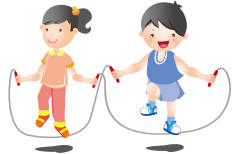 Leisure and Cultural Services Department - Healthy Exercise for All CampaignLeisure and Cultural Services Department
Leisure and Cultural Services Department - Healthy Exercise for All CampaignLeisure and Cultural Services Department
Rope Skipping for Fun
Introduction
According to the findings of the Territory-wide Physical Fitness Survey for the Community. The overall findings of the survey revealed that although most of the physical fitness parameters have improved across different age groups compared to the findings of a similar survey a decade ago, reflecting the growing health awareness of the public. The findings also indicated, however, that more than half of the public did not meet the daily physical activity level as recommended by the World Health Organization (WHO). Children and the adolescent should do at least an average of 60 minutes per day of moderate- to vigorous-intensity physical activity, mostly aerobic, across the week while Adults should do at least 150-300 minutes of moderate-intensity aerobic physical activity; or at least 75-150 minutes of vigorous-intensity aerobic physical activity; or an equivalent combination of moderate- and vigorous-intensity activity throughout the week.
Rope skipping is a simple and effective physical activity that can help you enhance your physical fitness and maintain a good figure, as well as improve your agility and stamina. Rope skipping requires very simple equipment; all you need is just a rope, loose and comfortable clothing, and a pair of suitable sport shoes. Moreover, rope skipping does not require much space or a special venue. There is also no restriction on the number of participants; you can skip alone or in groups. The rhythm of rope skipping can be varied to suit different people. You can adjust the amount of exercise according to your physical fitness.
Benefits of Rope Skipping
1. | Strength neuromuscular coordination, improve agility and reaction time; |
2. | Improving your cardiopulmonary functions and blood circulation; |
3. | Reducing the risk of developing cardiovascular disease, hypertension, stroke and diabetes mellitus and preventing some types of cancer (e.g. colorectal cancer); |
4. | Strengthening your muscles and reducing the risk of osteoporosis; |
5. | Enhancing the mobility and flexibility of joints to lower the risk of injuries and falls; |
6. | Relieving stress, boosting confidence and improving mental health; and |
7. | To burn calories# and help you maintain a healthy body weight. |
# To learn more about the calories expended during physical activities will help weight management:
Example: Rope skipping for 10 minutes continuously at the intensity of 60-80 per minute, the amount of calories expended are as follows:
| Weight (Kg) | 40 | 45 | 50 | 55 | 60 | 65 | 70 | 75 | 80 |
| Calories Expended (kcal) | 59 | 66 | 73 | 81 | 88 | 95 | 103 | 110 | 117 |
(Note: The information given above is for reference only. The actual amount of energy expended is determined by factors such as intensity and duration of an activity, and the physical fitness, skill level, gender, age, body weight of an individual.)
Rope Skipping Safety Tips
* | Skip rope on a smooth surface; |
* | For indoor rope skipping, mind the headroom and keep a distance from things like wall mounted fans, ceiling fans and furniture; |
* | If there are more than one skipper, skippers should keep a safe distance from each other to avoid injuries by the ropes; |
* | Replenish water from time to time during exercise; |
* | If feeling too tired during exercise, stop the strenuous activity to prevent muscle and joint injuries; and |
* | When feeling unwell during exercise, stop immediately and seek medical assistance or professional help. |
Five Steps to Follow in Rope Skipping
| 1. | Choose a suitable rope |
| Choose a rope that suits your height. A rope of the right length can be swung over your head and under your feet smoothly. A rope which is to short or too long will hamper skipping movements. How to measure Stand on the middle of the rope and lift both ends of it. The ends of the rope should reach your chest (or slightly lower) and palm up (see illustration on the right). |
| 2. | Choose suitable sport shoes |
| To reduce the impact of skipping on your feet, choose a pair of sport shoes with good shock absorbing function. |
| 3. | Do warm-up exercises before skipping |
Do gentle stretching exercises for warming up. Hold each posture for 10 to 30 seconds to allow your body temperature to rise slightly and your muscles to get prepared for further exercises. The warm-up exercises normally takes 10 to 15 minutes, but the duration should be adjusted according to the prevailing temperature. |
| 4. | Maintain proper postures
|
| 5. | Do cool-down exercises after skipping |
| Relax completely and take deep breaths. You may repeat the warm-up exercises or have a leisure walk so as to help your body temperature, breathing and heartbeat rate return to normal. |
Acknowledgements:
The Hong Kong Rope Skipping Association, China
Physical Fitness Association of Hong Kong, China




